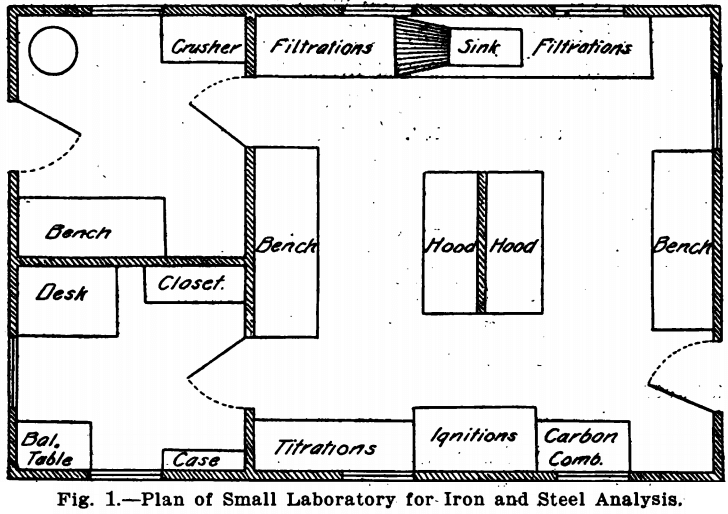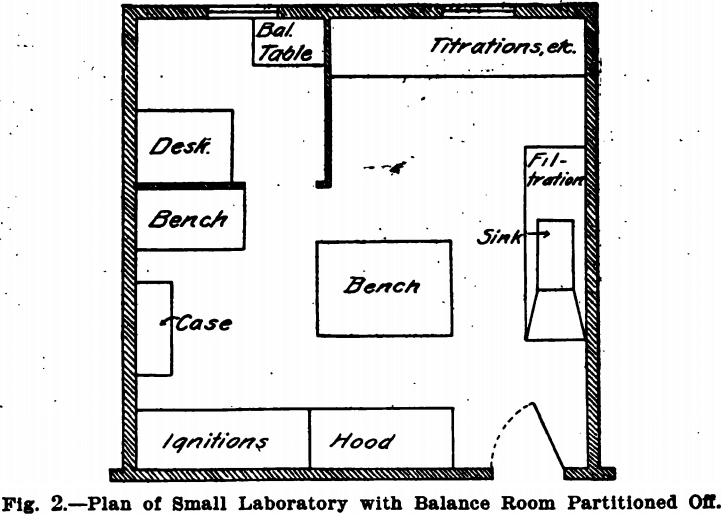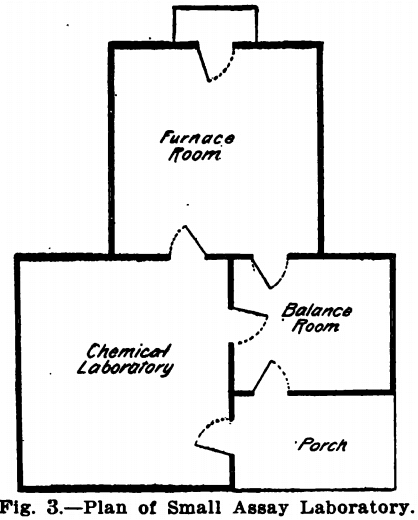Table of Contents
In designing and equipping an analytical laboratory, two aims must be kept always in mind—First, to promote accuracy, and second, to economize time and labor. Don’t make the mistake of sacrificing the former unnecessarily to the latter, but always save time and labor when possible and to that end arrange your laboratory systematically. Nothing so facilitates rapid work as having a place for everything and doing everything in that place. Where space permits, have a separate table for carbon combustions, for ignitions, extractions, evaporations, for titrations, precipitations with H2S, distillations and for electro-chemical analysis, filtrations and various and sundry special tests.
Analytical Laboratory General Arrangement
The location of the laboratory is usually controlled by circumstances. Sometimes it is a separate building, sometimes part of an office building and sometimes a room or rooms in the mill or factory set apart for the purpose. If a separate building is made for the laboratory special features can be incorporated in its design. If, however, the laboratory is to be located in an office or factory building, the chemist has usually to content himself with what he can get. The laboratory if possible should consist of three rooms, two of which should be neatly finished inside and intended for the analytical work, and the third of which may be merely a shed room to be used for the preparation of the samples, etc. Where only one room is available for the laboratory, a small room should be wainscotted off a corner of the large one for a balance room. The size of this balance room will usually be controlled by that of the large one. If permissible, it should be large enough for a desk, book-case and balance table. When possible it should always include a window; if not, the upper half of the sides may be made of glass. Indeed, even when a window is present, it is convenient to do this, running the glass low enough to permit of any one seated at the balance or desk seeing out into the room. In this way the chemist can keep track of things while weighing or writing.
Best Place to Build an Analytical Laboratory
If a choice is offered in locating the building or selecting a room, get as far away from the noise, dirt and vibration of the mill, furnace or smelter as circumstances will permit. If the laboratory is to be located in an office building of two or more stories, there are several things to be said in favor of locating on the lower floor. The chief advantage is having a firm foundation for the balance, such as can be obtained by erecting a short brick or concrete pier. Its disadvantages are usually annoyance to the chemist from business callers for the office, and annoyance to the office force from the fumes rising from the laboratory. However, properly posted signs (using foreign words where foreign labor is employed) in the hallways, and good ventilation and hoods in the laboratory will usually do away with these annoyances.
In the new office building of the Dexter Portland Cement Co., the laboratory is located on the second floor, the balance room being directly over a heavy concrete fire proof vault for the storage of papers, etc. The balances are mounted on concrete pier resting on the vault sides and roof and are free from vibration. This arrangement is excellent and is one which can be followed in many places. A little further on in the book a method will be described for mounting balances in factory buildings, etc., where they are subjected to jar and vibration.
When large samples have to be reduced either by hand or mechanical means this may be conveniently done in the basement of the office building.
Analytical Laboratory Lighting & Ventilation
The laboratory should be provided with a high ceiling. It should be well lit either from windows or a skylight. The windows should come near the ceiling, so that ventilation can be secured when necessary by lowering the upper sash. If a skylight is used it should be provided with ventilators. In some laboratories artificial ventilation must be resorted to, in which case a fan (run by an electric motor) located in the upper part of one of the windows will help matters.
Floor, Walls and Ceiling
The floor of the laboratory should be of some material, hard wood is best, which can be cleaned easily. Concrete and tile floors are very trying, for the analytical chemist is on his feet so much that he is apt to find such a hard floor very fatiguing. Concrete floors may be covered with felt or corrugated rubber matting which can be easily cleaned and lessens the fatigue of those standing on it. Old floors full of cracks can be covered with oilcloth or linoleum. This latter makes an excellent floor covering, as it can be easily cleaned.
The walls and ceilings should be finished in some material such as hard wall plaster or cement, which is not readily attacked by acid fumes. If the wall is old and there is danger of grains of sand and lime dropping in beakers, dishes, etc., it is best to cover the plaster with wall paper. This should be of a light pattern, so as not to darken the room. It is probable that wood is really the best covering for the walls and ceilings of the laboratory, as it is not attacked by acid fumes. Metal ceilings are most objectionable, and all exposed metal beams should be well protected by either aluminum paint or asphalt varnish, to prevent corrosion from acid fumes. The electric wiring should always be concealed under the ceiling, as the acid fumes rapidly attack the copper wire, and the lamp socket should be of porcelain.
Heating Appliances
For heating the laboratory, hot water or steam is to be preferred. Air is objectionable from the dust it usually carries. If the laboratory is located near the boilers, steam for heating can usually be obtained from these. The heating apparatus of the balance room should not be too near the balances.
Interior Arrangement
The interior arrangement of the laboratory will depend somewhat upon the kind of work that is to be done. In every laboratory, however, there should be a hood, a sink, a burette table and a bench for general work. In all the laboratories which the writer has designed he has set aside one special stone topped table on which to place the blast lamps and burners used for igniting precipitates, and one special bench to use for long stemmed funnels.
The inside arrangement of a laboratory can best be illustrated by giving plans of several laboratories.
Laboratory for Iron and Steel Work
Figure 1 shows the arrangement of a model small laboratory for iron and steel work, consisting of a one-story frame building with three rooms. The main laboratory is 20 x 19 feet, the balance room 10 x 9, and the sample room 10 x 11. The balance room is located at the northeast comer, giving a north light on the balances. It is large enough to accommodate a bookcase, roller top desk, balance table, and the necessary chairs. The room for the preparation of samples contains a small Bosworth crusher for reducing ores, a drill for making borings, mortar, pestle, etc. The center of the analytical laboratory is occupied by the hood. The details of this are shown in Fig. 4. It is divided into two compartments, so that silica may be determined in one side by Drown’s method, while sulphur is being determined on the other by oxidation, without danger of contaminating the latter by the former. The sink is at one end of the double hood and a stone top ignition table at the

other. Two general work benches face the two hoods, and the ignition table is flanked on one side by the burette table and on the other by the table for carbon combustions, also stone topped. The sink has a table provided with vacuum on each side of it. The advantage of the arrangement with the hood in the center is that the one laboratory is practically divided into two, and two men can easily work here without interfering with each other in any way; each hood is accessible to the sink, to a large work bench, and to the table with the vacuum pumps.
Fig. 2 shows another arrangement of a laboratory 16 x 18 feet. Here a balance room has been cut off from the main room by a wainscotted partition. It is 7 x 8 feet and does not much more than accommodate the desk and balance table and chairs

for the two. It is taken from a corner of the room which gives a north light, and as it takes one of the only two windows of the

room, the partition is of glass, to help light the main laboratory. The arrangement is evident from the plan. The hood, sink and large bench are near together, and most of the work is done here, leaving the other benches for special determinations. As the large central bench is double, one man can work at each side of it. If necessary, the hood can be divided into two compartments.
Assay Laboratory
Fig. 3 shows the design of a laboratory for fire assay work. This consists of three rooms, an office, an assay room and a chemical laboratory. The assay room contains a crucible furnace, a muffle furnace and a roaster if sulphide ores are assayed. It should also contain a coal bin, the necessary crushing and grinding machinery for preparing samples, a rough balance for weighing the fluxes for crucible assays, etc. In the office will, of course, be the button balance, the pulp balance and the analytical balance, besides the necessary chairs, desk, cases, etc. The chemical laboratory should be provided with hood, sink and work benches, as usual. If properly equipped this laboratory will take care of a great deal of work.
